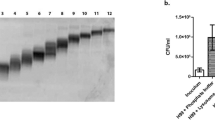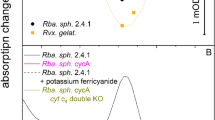Abstract
CYTOCHROME c-like compounds have been found to be proximate to rat kidney lysozyme in fractions derived from ion-exchange chromatography on ‘Amberlite IRC-50’ resin1. This led to experiments designed to test the effects of cytochrome c upon bacterial lysis by lysozyme. Although under certain conditions oxidized cytochrome c was found to increase the initial rate of lysis by lysozyme, the pigment alone had no antibacterial activity in vitro. In testing the potential activity of cytochrome in vivo, M. lysodeikticus was grown in the presence of lysozyme in very low concentrations (0.1 µgm./ml.) as a control. In this way the production of resistant cells was first observed.
This is a preview of subscription content, access via your institution
Access options
Subscribe to this journal
Receive 51 print issues and online access
$199.00 per year
only $3.90 per issue
Buy this article
- Purchase on SpringerLink
- Instant access to full article PDF
Prices may be subject to local taxes which are calculated during checkout
Similar content being viewed by others
References
Litwack, G., Bacteriol. Proc., Detroit, 99 (1957).
Litwack, G., Proc. Soc. Exp Biol. and Med., 89, 401 (1955).
Litwack, G., and Pramer, D., Proc. Soc. Exp. Biol. and Med., 91, 290 (1956).
Repaske, R., Biochim. Biophys. Acta, 22, 189 (1956).
Szybalski, W., and Bryson, V., “Origins of Resistance to Toxic Agents”, edit. by Sevag, M. G., Reid, R. D., and Reynolds, O. E., p. 20 (Academic Press, New York, 1955).
Author information
Authors and Affiliations
Rights and permissions
About this article
Cite this article
LITWACK, G. Development of Micrococcus lysodeikticus Resistant to Lysozyme. Nature 181, 1348–1350 (1958). https://doi.org/10.1038/1811348c0
Issue date:
DOI: https://doi.org/10.1038/1811348c0



